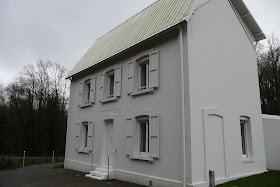Alas as we arrived it was obvious all was not well, not a car in the car park, no visitors, nobody in sight.
We walked to the setting of where the two carriages had been when the Armistice had been signed, not a soul,
we went to the museum gates there it was, another door barred, NOT OPEN UNTIL FEBRUARY, this is getting out of hand, barred from getting my Craster Kippers, now not able to visit one of the main historical sites in the world. But it was a good job it was closed because otherwise we would have had a wasted journey, as another notice told us of the normal opening hourse and saying it is closed on Tuesdays, guess what it was Tuesday, but I bet you when I come next time I will have forgotten that piece of useful information.
So we had a look around what was to be seen, war machines and monuments to mans stupidity towards fellow man.
we then went into Compiègne to do a bit of shopping and a bit of lunch (alas most of the shops were closed as the next day was the start of the sales), but it is always nice to pop into a French town at lunchtime and have a Plat de Jour, the fantastically sensible daily set menu.
Helen had the duck rillette and I had the mixed charcuterie
Very nice simple starters.
Then helen had the Boeuf Bourguignon
I had the tranche de porc, both served with green beans a very tasty meal and great value for money at €10,- per head.
I spent the next couple of days visiting various battle fields and other historical areas of interest. I also was on line quite a bit as I was looking for a camper van, I found a one at last and as I was heading to Bonn and it was nearby, decided to head up to Belgium and on into Germany the next day. So saying my fond fairwells I headed off, thanks once again for the wonderful hospitality and company Family Bond.
I had noted that on route (with just a little detour) was the grave and site of Wilfred Owens memorial, the WW1 poet is buried in the local village graveyard of Ors (for those looking for it, go to the railway station, the village grave yard is adjacent to it).
Walk through the gates and passing the grave yard cross, you will see the Commonwealth Wargrave Portland stone cross and the trim rows (three in all) of headstones of the troops that fell on that morning in November 95 years ago.
Wilfred is buried in the rear row 3rd grave from the left, I am sure you will not miss it as there will be the wreaths of poppies adorning it!
A short trip through the forest brings you to the museum that had been built by the locals to commemorate the poet. This is the building, the forester's house, where he and his comrades at arms had spent their last night in the cellar before the push to cross the nearby canal (Sambre-Oise), he never made it, he met his death trying and this was only a few days (4th Nov) before the guns fell silent on the 11th of November.
If you pass this way take a little time and stop in this tiny village near the Belgium border and reflect on the waste of life.
While he sat in the cellar with his troop, he wrote a letter home to his mother, it was the last thing he ever wrote, his mother received it on the 11th November Armistice day, as the bells chimed out for peace.
Some of the words from that letter are engraved in the wall that leads down to that cellar.
 |
| The inscription |
"Dearest Mother,
So thick is the smoke in this cellar that I can hardly see by a candle 12 inches away. And so thick are the inmates that I can hardly write for pokes, nudges, and jolts. On my left, the company commander snores on a bench. It is a great life. I am more oblivious than the less, dear mother, of the ghastly glimmering of the guns outside and the hollow crashing of the shells.
I hope you are as warm as I am, soothed in your room as I am here. I am certain you could not be visited by a band of friends half so fine as surround us here. There is no danger down here - or if any, it will be well over before you read these line..."
I felt very, very moved and did feel a little sad, I was given a private showing of the memorial to Wilfred Owen by a wonderful young lady from the local tourist board, below in the barrel vaulted cellar. Outside has been transformed into a small ampthitheatre and here during the year friends of his and other war poets gather to enjoy recitals.
The rooms above have been transformed into a visual and audio happening, his poems being read and at the same time projected onto the walls and roof. Very touching, it cannot but move anyone hearing and seeing those words about the terrors of war.


























No comments:
Post a Comment